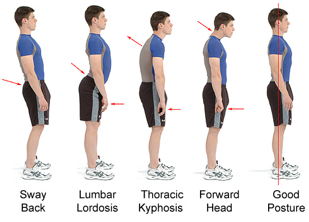Bad Posture and Correction
Dr. Dennis Woggon, founder and director of the St. Cloud Chiropractic Clinic in St. Cloud, Minn., and the author of more than 50 articles and books on spinal biomechanics, says we need to be mindful of good posture. “Posture is the window to the spine,” says Dr. Woggon. “If you have poor posture, you can have a myriad of problems such as headaches, backaches, numbness in hands, constipation, neck pain [and] numbness in feet.”
So why do so many of us have poor posture? This picture might explain it a bit…
Bad posture comes in many forms as demonstrated here:
But good posture comes in only one form, with your ear, shoulder, hip and ankle in a straight line from the side, and a straight spine when looking from the back with level ears, shoulders, and hips.
So where do we go wrong?
Primarily, Forward Head posture, the most common improper posture that I see, starts in the very top of the neck. We all have activities in our lives in which we demonstrate improper posture… whether it’s driving a car, watching television, slouching all day in class, and especially bad ergonomics when it comes to our favorite new hobby, sitting at a computer staring at the screen for hours at a time. Below on the left is a near normal curve of the neck, and to the right is a straight neck. One of the main issues is head weight. Your head weighs approximately 10lbs; a bowling ball if you will. For every inch that your head moves forward, it adds 10 lbs of apparent head weight, or how heavy your head feels for your muscles to hold in place. To demonstrate this, pick up a 10lb bowling ball and hold it close to your body, now move it out until it is at arm’s length. Although the weight doesn’t change, it sure does feel heavier, doesn’t it!
The issue here isn’t just structural. Have you ever pulled a loose thread from a shirt or sweater and have it stay intact? What happens? You are holding onto a straight, tight piece of thread and in the shirt the thread gets all bunched up and curvy to compensate. The spinal cord will do the same thing. Pulled into a straight line in the neck, the spinal cord will become stretched and placed under tension, like tightening a rubber band or straightening a banana. What can happen? Over time will it tear and rip? Probably not, instead, it will tell the body to shorten up in other places often leading to improper side to side curving to release the tension, creating a scoliosis. So what can you do? Below are a couple simple examples…
Men, remove the wallet when sitting!!!
Women, lighten up the load in the purse!!!!
Kids (and adults), stop slouching at the computer!!!
Another thing you can do is evaluate your spine at home for bad posture. Have someone look at some specific landmarks. From behind, check the levelness of your ears, your shoulders and the tops of your hips. From the side, check to see if your ear, shoulder, hip and ankle are lined up. This is something you can practice when you are out shopping or waiting in a line with the stranger next to you or one aisle over…just don’t get caught staring!
So what can we do for you? We can do a proper spinal analysis with specific measurements to find the source of the improper posture and begin to correct it. Along with specific posture corrective (no sweat) exercises, the process of correction can begin immediately.
We deal with posture problems all the time, especially in today’s technological age. So take the time to get your spine and posture checked. Can I give you some exercises here? No. Why not? Because we are all unique. The human spine has 24 moveable segments, plus the skull, sacrum and 2 ilia, for a total of 28 segments. This means 304,888,344,611,714,000,000,000,000,000 combinations of misalignment, and with those odds, WE DON’T GUESS, WE TEST!!!
Once you’ve been given a proper spinal analysis, your doctor will be able to determine the best care for your specific needs.
Contributed by Dr. Jason Nobles



